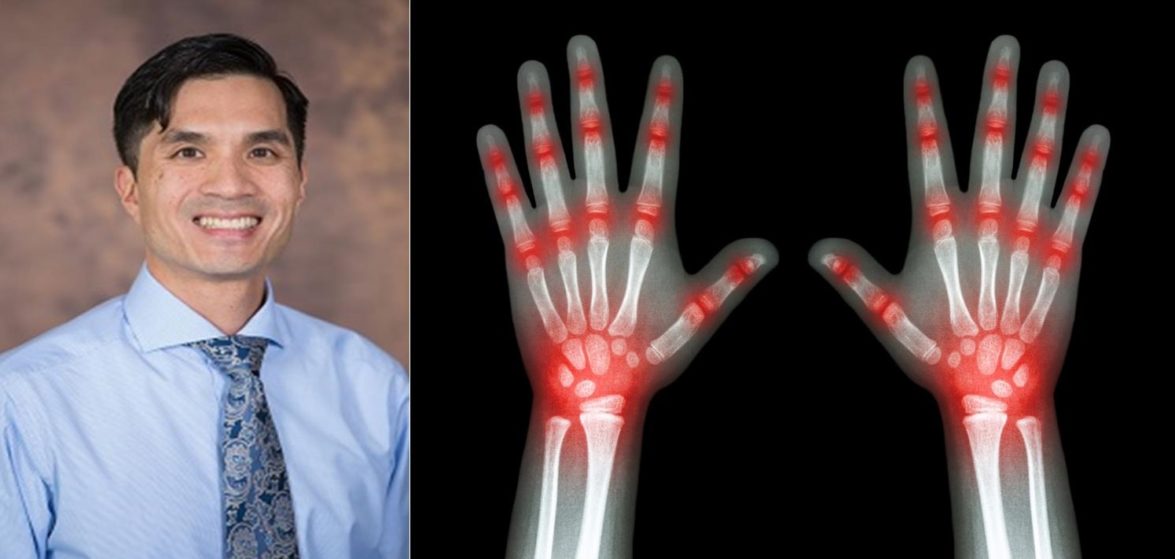Peter Chiraseveenprapund, MD, (you can call him “Dr. Chira”) is a man on a mission. He’s a pediatric rheumatologist at Rady Children’s Hospital-San Diego, and cares for kids with conditions including juvenile arthritis, lupus and scleroderma. He’s an associate professor of clinical pediatrics at University of California San Diego School of Medicine. And he’s working to create a world of health care in which shifting kids with chronic conditions from pediatric care to adult care is seamless and stress-free. In recognition of Juvenile Arthritis Awareness Month, and of all Dr. Chira does for the field of rheumatology, take a few minutes to learn more about this forward-thinking physician.
What inspired you to be a pediatrician, and specifically, a pediatric rheumatologist?
I was always interested in adolescent health and development. As I rotated through pediatric rheumatology as a pediatrics resident, I realized this was a great combination of working with this age group, as well as being able to help patients with chronic, complex medical conditions. I enjoy the interplay of patient and family education, using new and exciting treatments that have markedly improved outcomes of childhood onset rheumatologic diseases, and the strong connections we have with our patients through time.
In the research world, is there anything exciting coming down the pike for kids with juvenile arthritis?
There are many new agents available to get rheumatologic diseases under control, usually going through the adult population first. At Rady Children’s, we participate in clinical research trials to ensure these are safe and effective in our pediatric rheumatology population. Additionally, we work along with national research programs to try to determine what treatments, whether they are older, newer or some combination thereof, are most effective for a particular patient. We are proud to offer the chance for all children who come to our clinic to be part of our research program, whether it is the Childhood Arthritis and Rheumatology Research Alliance registry where we are doing long-term tracking or the clinical trials noted above.
Your research emphasizes the importance of streamlining and innovating the process of patients going from pediatric to adult care. How do you bring that into your work with patients here at Rady Children’s?
I have been working with residents who are training in internal medicine and pediatrics to look at the needs of both pediatric and adult providers and their knowledge of transition. With these needs assessments, we are trying to develop tools to better transfer/transition our patients from our clinics to the adult providers’ clinics so it is smoother. This process takes time and lots of buy-in from families, hospital systems and the health care providers. We are currently trying to look at providing patients with a useful medical summary that they and their new providers can use.
What are some common fears or misconceptions patients/patient families may have about juvenile arthritis? What would you say to address them?
The first thing that most families say is, “I didn’t know kids could get arthritis.” We spend lots of time educating patients and families about the disorders, how our goal is to keep a child moving and functioning well in spite of their arthritis, and that medicines and aggressive treatment have been crucial and instrumental to get kids to look so well. Unfortunately, we do not have a cure yet, but we have been able to prevent children from being disabled from their arthritis, which used to be a common occurrence. We tell parents and kids all the time that our goal is to have people not even know their child has arthritis and hopefully, with treatment, potentially go into a remission where they can come off medicines.
Describe your approach to caring for patients with juvenile arthritis.
My approach is multifaceted. Of course, medicines are important as they control the underlying biological process, and we try to tailor the treatment plan based on the patient’s specific arthritis symptoms. We also take into account patient preferences and our own experiences with the medicines. Additionally, we look at other resources to get patients to the functional state. These include physical and occupational therapy; working with counselors and psychologists; and having patients and families learn to advocate for themselves in school, the community and even the government. We work closely with organizations such as the Arthritis Foundation and Lupus Foundation and encourage our patients and families to tap into those resources.
What is your favorite place you have traveled so far, and why? Where is next on your vacation list?
I’ve been fortunate to get the travel the world. Every place has its unique qualities, but given our proximity to the Hawaiian Islands, I do enjoy trips there because it is tranquil there. I hope to go to Machu Picchu or South Africa in the near future.
Sounds like your dog is one of your best buds. Tell me about him/her.
Orey is great. She’s an adorable Australian shepherd/cattle dog mix. She goes everywhere with us, so San Diego has been great for her. She also is getting some arthritis as she ages, so I put on my rheumatologist hat every once in a while for her.
You’re a foodie — if you could create your ultimate meal, what would be on the menu?
Having grown up Thai and visiting Bangkok since childhood, I would have to say street food from Thailand. There is so much variety to be found in the various food stalls.
If you could only watch five movies for the rest of your life, which would you choose?
“Cinema Paradiso” and then anything by Pixar.
What is your most treasured possession, and why?
Family and friends — they provide the chance to share experiences and adventures and then we can reminisce about them afterwards.
